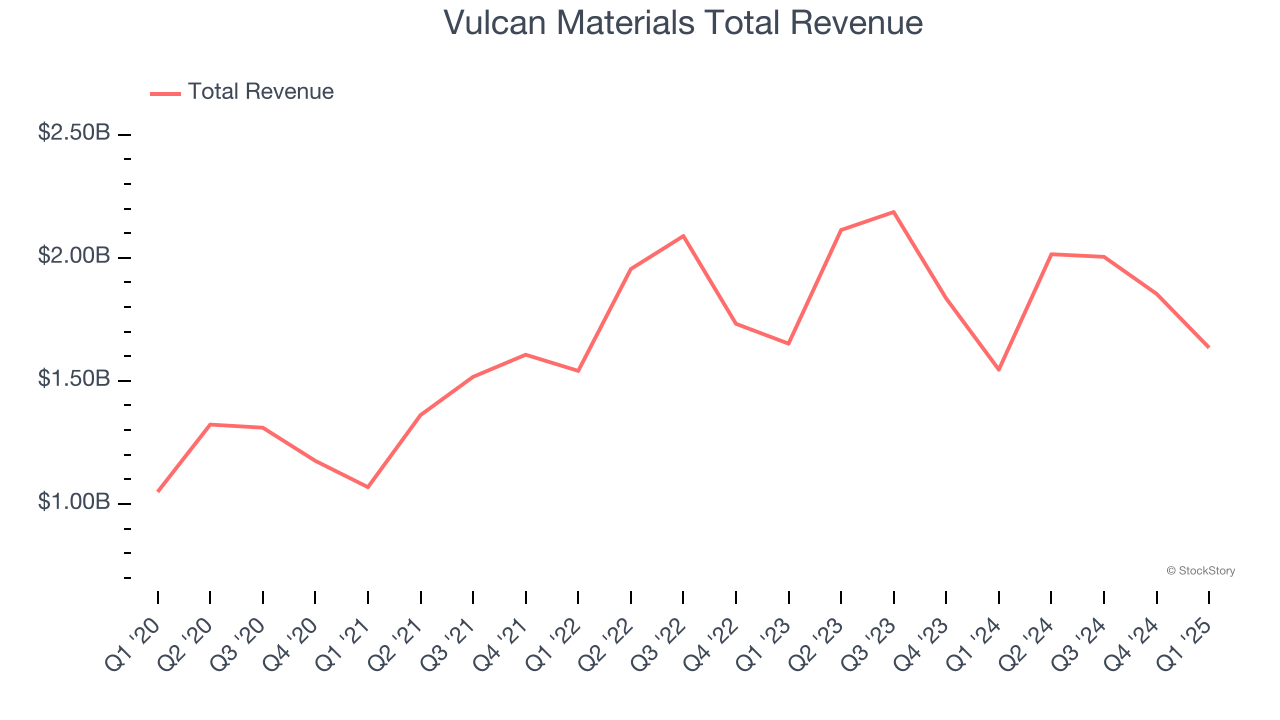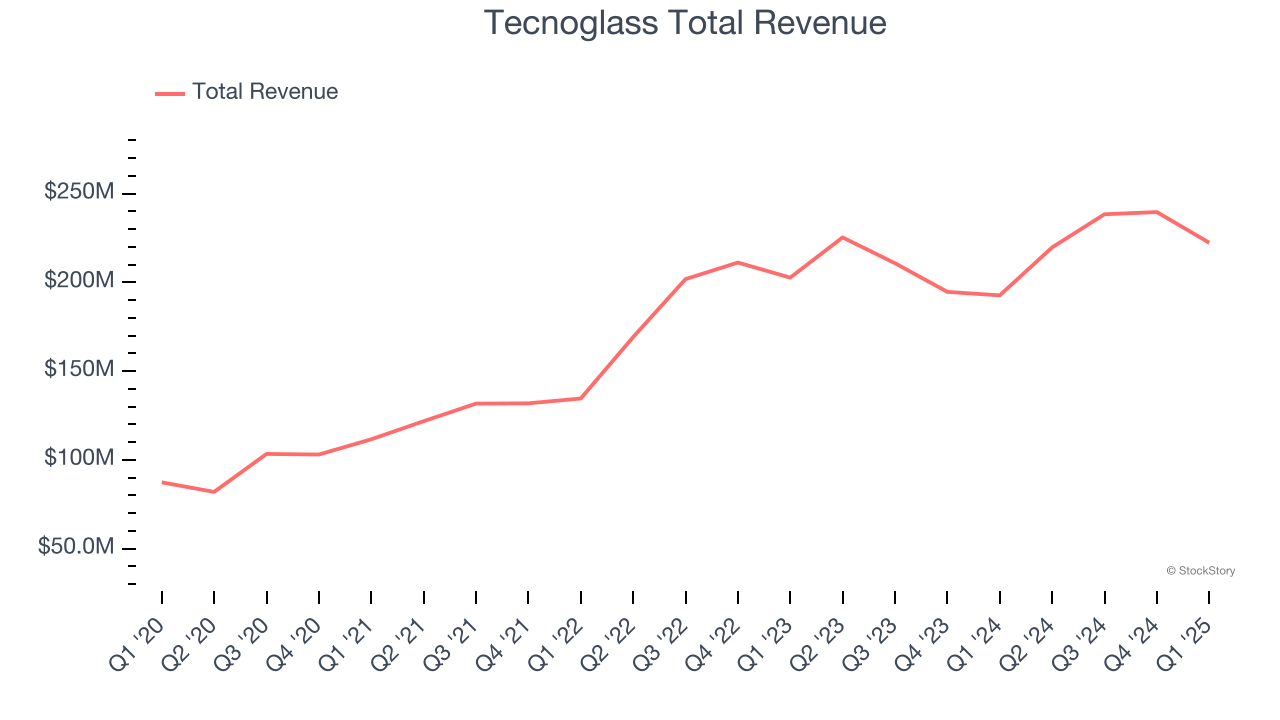
As the Q1 earnings season wraps, let’s dig into this quarter’s best and worst performers in the building materials industry, including Vulcan Materials (NYSE: VMC) and its peers.
Traditionally, building materials companies have built competitive advantages with economies of scale, brand recognition, and strong relationships with builders and contractors. More recently, advances to address labor availability and job site productivity have spurred innovation. Additionally, companies in the space that can produce more energy-efficient materials have opportunities to take share. However, these companies are at the whim of construction volumes, which tend to be cyclical and can be impacted heavily by economic factors such as interest rates. Additionally, the costs of raw materials can be driven by a myriad of worldwide factors and greatly influence the profitability of building materials companies.
The 9 building materials stocks we track reported a satisfactory Q1. As a group, revenues beat analysts’ consensus estimates by 0.6% while next quarter’s revenue guidance was in line.
Thankfully, share prices of the companies have been resilient as they are up 9.3% on average since the latest earnings results.
Vulcan Materials (NYSE: VMC)
Founded in 1909, Vulcan Materials (NYSE: VMC) is a producer of construction aggregates, primarily crushed stone, sand, and gravel.
Vulcan Materials reported revenues of $1.63 billion, up 5.8% year on year. This print fell short of analysts’ expectations by 2.8%, but it was still a strong quarter for the company with an impressive beat of analysts’ EPS estimates and a solid beat of analysts’ adjusted operating income estimates.
Tom Hill, Vulcan Materials' Chairman and Chief Executive Officer, said, "The combination of our aggregates-led business and our consistent focus on our Vulcan Way of Selling and Vulcan Way of Operating disciplines resulted in strong earnings growth and margin expansion in the first quarter. Adjusted EBITDA increased 27 percent, and Adjusted EBITDA margin expanded 420 basis points over the prior year. Aggregates cash gross profit per ton improved 20 percent with widespread improvements across our footprint. Our commercial and operational execution support our full-year outlook to deliver another year of earnings growth in 2025. "

Vulcan Materials delivered the weakest performance against analyst estimates of the whole group. Interestingly, the stock is up 7.9% since reporting and currently trades at $264.48.
Is now the time to buy Vulcan Materials? Access our full analysis of the earnings results here, it’s free.
Best Q1: Tecnoglass (NYSE: TGLS)
The first-ever Colombian company to trade on the NASDAQ, Tecnoglass (NYSE: TGLS) is a manufacturer of architectural glass, windows, and aluminum products.
Tecnoglass reported revenues of $222.3 million, up 15.4% year on year, outperforming analysts’ expectations by 3.3%. The business had an exceptional quarter with a solid beat of analysts’ adjusted operating income estimates.

The market seems happy with the results as the stock is up 7% since reporting. It currently trades at $75.64.
Is now the time to buy Tecnoglass? Access our full analysis of the earnings results here, it’s free.
Weakest Q1: UFP Industries (NASDAQ: UFPI)
Beginning as a lumber supplier in the 1950s, UFP Industries (NASDAQ: UFPI) is a holding company making building materials for the construction, retail, and industrial sectors.
UFP Industries reported revenues of $1.60 billion, down 2.7% year on year, falling short of analysts’ expectations by 1.9%. It was a disappointing quarter as it posted a significant miss of analysts’ adjusted operating income estimates.
UFP Industries delivered the slowest revenue growth in the group. As expected, the stock is down 5.4% since the results and currently trades at $100.72.
Read our full analysis of UFP Industries’s results here.
Sherwin-Williams (NYSE: SHW)
Widely known for its success in the paint industry, Sherwin-Williams (NYSE: SHW) is a manufacturer of paints, coatings, and related products.
Sherwin-Williams reported revenues of $5.31 billion, down 1.1% year on year. This result came in 1.6% below analysts' expectations. Zooming out, it was a mixed quarter as it also produced an impressive beat of analysts’ adjusted operating income estimates but a miss of analysts’ organic revenue estimates.
The stock is up 4.2% since reporting and currently trades at $345.69.
Read our full, actionable report on Sherwin-Williams here, it’s free.
AZEK (NYSE: AZEK)
With a significant portion of its products made from recycled materials, AZEK (NYSE: AZEK) designs and manufactures goods for outdoor living spaces.
AZEK reported revenues of $452.2 million, up 8.1% year on year. This print topped analysts’ expectations by 1.9%. Overall, it was a strong quarter as it also put up an impressive beat of analysts’ organic revenue and EBITDA estimates.
AZEK had the weakest full-year guidance update among its peers. The stock is up 4.4% since reporting and currently trades at $51.82.
Read our full, actionable report on AZEK here, it’s free.
Market Update
As a result of the Fed’s rate hikes in 2022 and 2023, inflation has come down from frothy levels post-pandemic. The general rise in the price of goods and services is trending towards the Fed’s 2% goal as of late, which is good news. The higher rates that fought inflation also didn't slow economic activity enough to catalyze a recession. So far, soft landing. This, combined with recent rate cuts (half a percent in September 2024 and a quarter percent in November 2024) have led to strong stock market performance in 2024. The icing on the cake for 2024 returns was Donald Trump’s victory in the U.S. Presidential Election in early November, sending major indices to all-time highs in the week following the election. Still, debates around the health of the economy and the impact of potential tariffs and corporate tax cuts remain, leaving much uncertainty around 2025.
Want to invest in winners with rock-solid fundamentals? Check out our Top 5 Growth Stocks and add them to your watchlist. These companies are poised for growth regardless of the political or macroeconomic climate.





